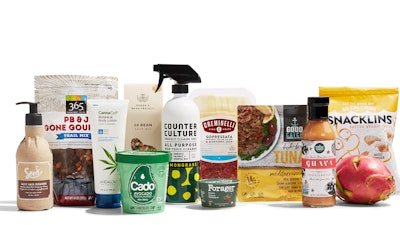
(BUSINESS WIRE) Whole Foods Market’s global buyers and experts revealed their thought on the most anticipated and innovative food trends for 2019. It's the company's fourth annual trends predictions announcement.
- Pacific Rim Flavors. Flavor inspiration from the Pacific Rim are popping up in grocery stores and restaurants. Ingredients like longganisa (a Filipino pork sausage), dried shrimp, cuttlefish and shrimp paste, as well as tropical fruits such as guava, dragon fruit and passionfruit. Jackfruit has become a popular meat alternative in place of items like barbecue pulled pork, while an extract of monk fruit, an ultra-sweet-tasting fruit also known as luo han guo, can be used as a sweetener replacing added sugars.
- Shelf-Stable Probiotics. New strains of probiotics such as Bacillus coagulans GBI-30 and Bacillus coagulans MTCC 5856 are making more shelf-stable applications possible. Wellness-focused brands are making it easier to get more probiotics in your day by adding functional probiotic ingredients to your pantry staples through products like granola, oatmeal, nut butters, soups and nutrition bars.
- Phat Fats. Fats are making a comeback, and the trendiest diets are on board. Keto, paleo, grain-free and even “pegan” (paleo + vegan) diets are growing more popular, meaning fats are starring ingredients in creative, convenient foods. Higher protein and lower-carb combos will also continue to trend across simple and easy snacking categories. New integrations of fat sources — like keto-friendly nutrition bars — are busting on the scene allowing consumers to get their fat fill with convenient treats.
- Next Level Hemp. Hemp hearts, seeds and oils are nothing new, but a new interest in the potential benefits stemming from other parts of hemp plants has many brands looking to explore the booming cannabis biz. While CBD oil is still technically taboo (prohibited in food, body care and dietary supplements under federal law), there’s more to this trend than CBD. Plant stem cells are being used in body care products and non-cannabis-derived sources from the endocannabinoid system, like phytocannabinoids that exist in nature, are also becoming more visible and prevalent due to the growing trend.
- Faux Meat Snacks. Eating more plants doesn’t mean you have to forgo beloved meaty flavors and textures. Plant-based foods will take on the meat-based snacking world of jerkies and pork rinds. Even those who don’t eat only vegan or vegetarian are exploring plant-based snacking.
- Eco-Conscious Packaging. The number of brands making the switch to packaging with the environment in mind continues to grow at a quickening pace. This includes advances in flexible product pouches, bans on plastic straws, and traditionally single-use packages going multi-use.
- Trailblazing Frozen Treats. While there is something comforting and classic about a scoop of vanilla ice cream, some consumers are wanting something a little less, well, vanilla. The new pints on the block are adding a fresh take with innovative bases like avocado, hummus, tahini and coconut water, and ice creams with savory swirls of artisanal cheese. Globally-inspired frozen desserts are also taking the stage, such as mochi and Thai rolled ice cream.
- Marine Munchies, Beyond Seaweed. Seaweed snacks rose to popularity a few years back and are now enjoyed by health-conscious adults and toddlers alike, however, experts expect even more ocean influence in the year to come. Sea greens are showing up in dishes like seaweed butter and kelp noodles and unique varieties of algae and kelp. Puffed snacks made from water lily seeds, plant-based tuna alternatives with algae ingredients, crispy snackable salmon skins with omega-3s and kelp jerkies are just a few testing the waters.
- Snack Time, Upgraded. Snacking across the board will take a turn toward the fancy, and snacks, as they start to usurp the usual three-meals-a-day routine, are anything but ordinary. Think charcuterie or cheese boards. Portable snack packages will feature bites like prosciutto and aged mozzarella, and artisanal versions of classic snacks like cheese or peanut butter cracker sandwiches. Ingredient-conscious snack and treat makers are creating new packaged snacks that take us back to our treat-loving childhoods but with higher quality ingredients, some of which are updated to accommodate special diets.
- Purchases that Empower. Much like last year’s Transparency 2.0 trend, consumer purchasing power continues to motivate changes in the food, beverage and body care industries, as shoppers expect more from the brands and businesses they choose to support. In 2019, thoughtful consideration behind purchases moves beyond environmental stewardship and animal welfare, and becomes more people-focused. Greyston Bakery practices an open hiring model — no questions asked — to practice what they call “radical inclusion,” which includes anyone who has faced barriers to employment. Kuli Kuli produces moringa powder which is often grown and processed by women, and has provided more than $1.5 million in income to women-led farming cooperatives, nonprofits and family farmers around the world through their organic moringa supply chain.
This year’s predictions came from Whole Foods Market’s culinary experts and industry leaders across the retailer’s more than 490 stores.






















